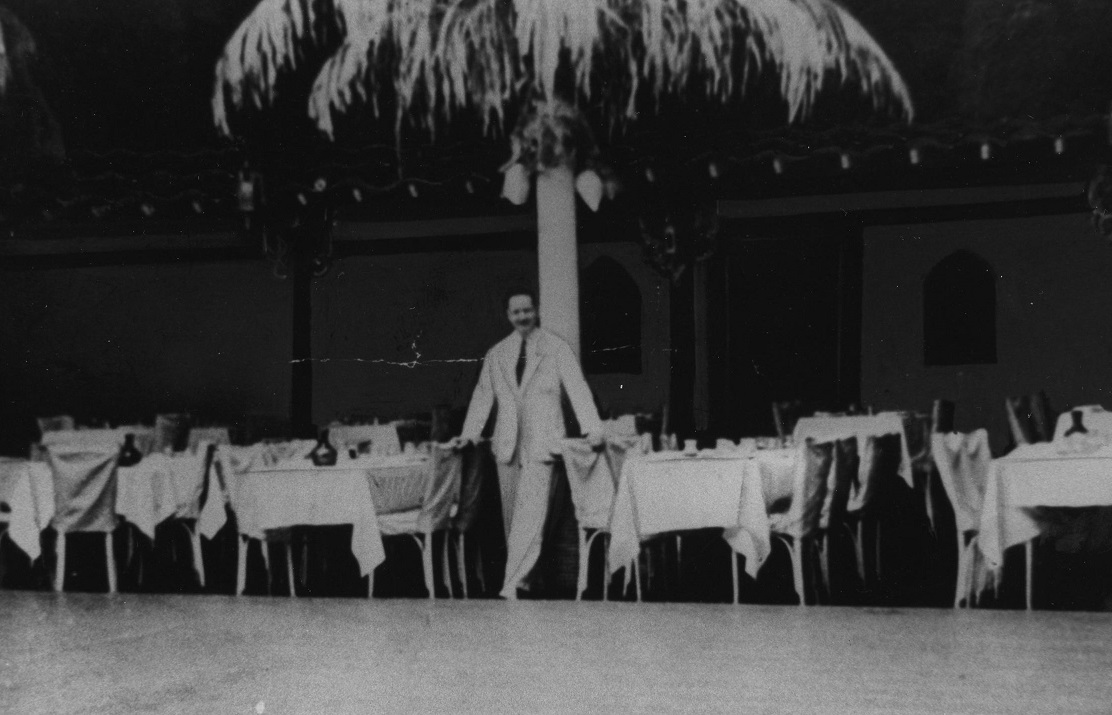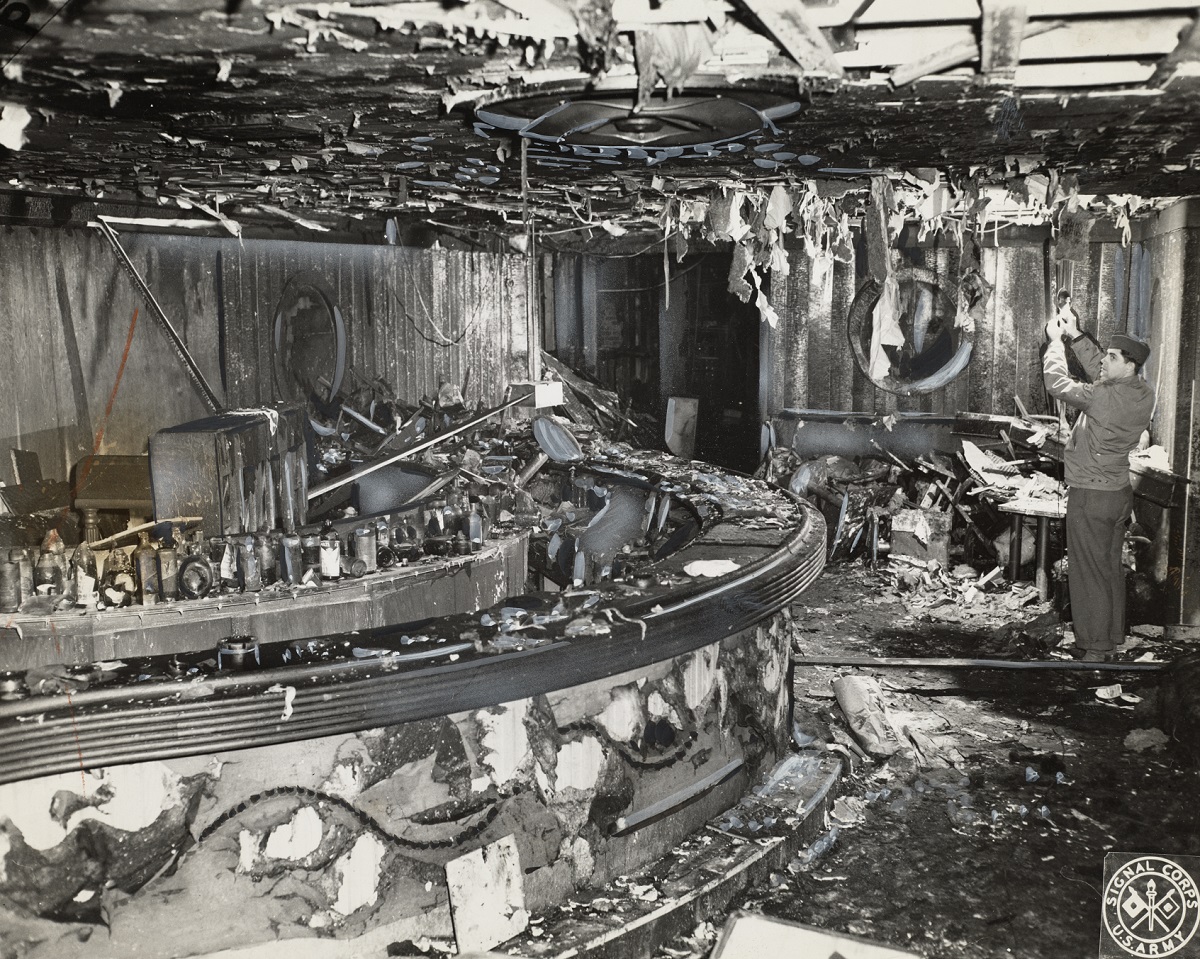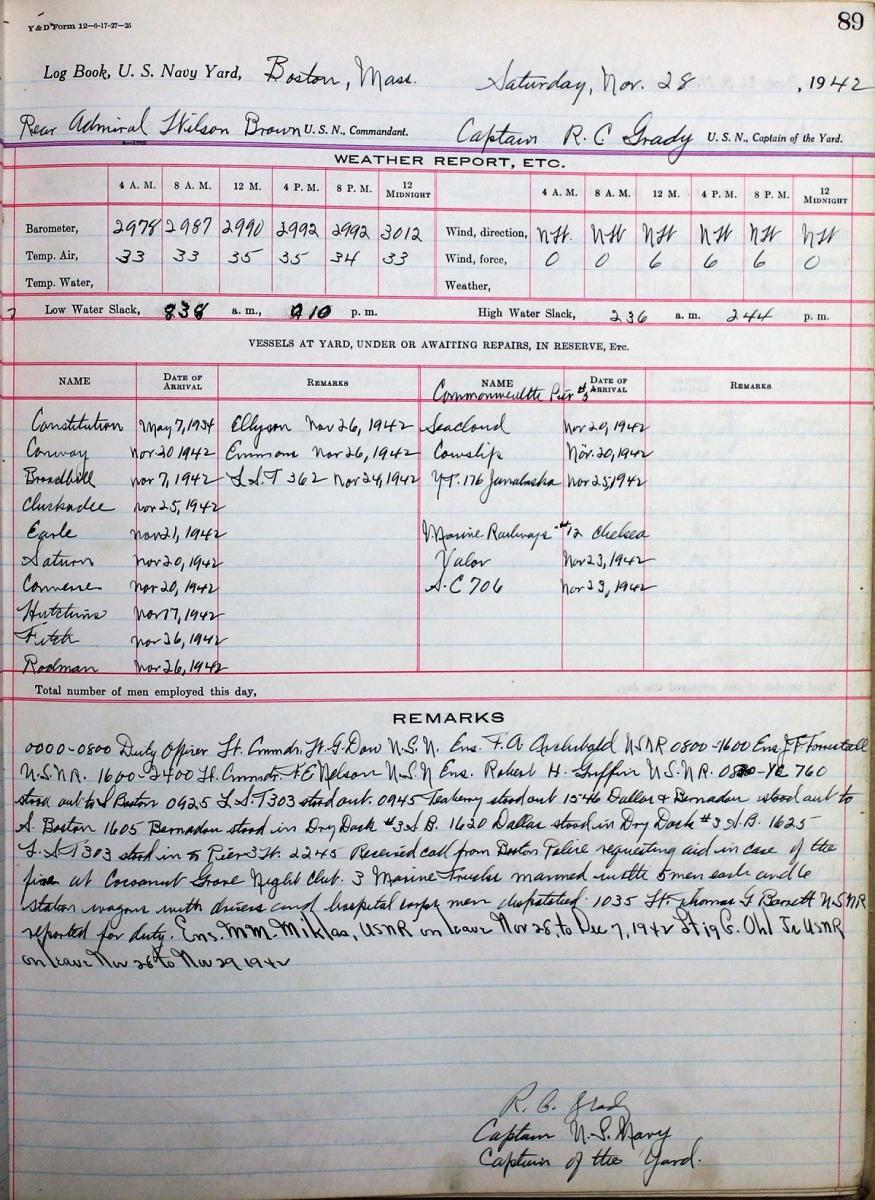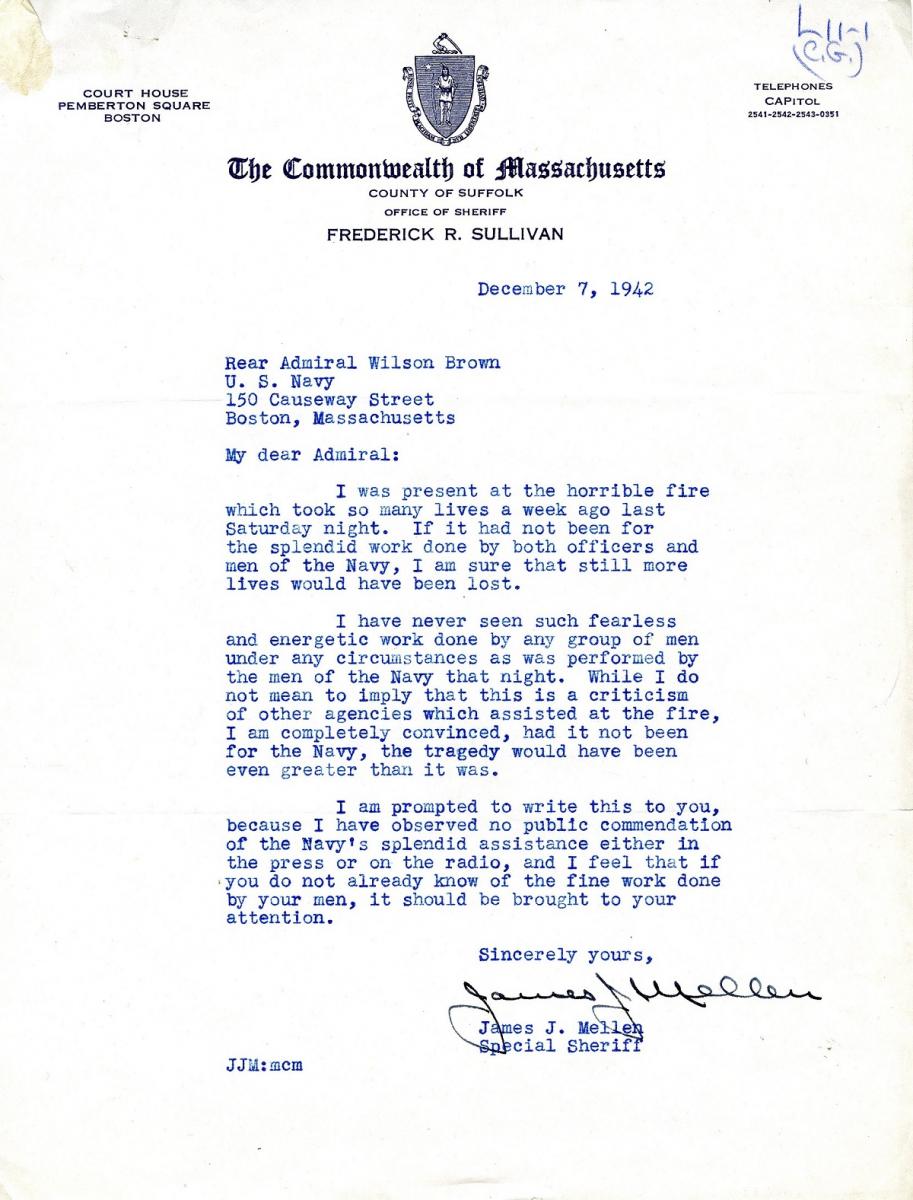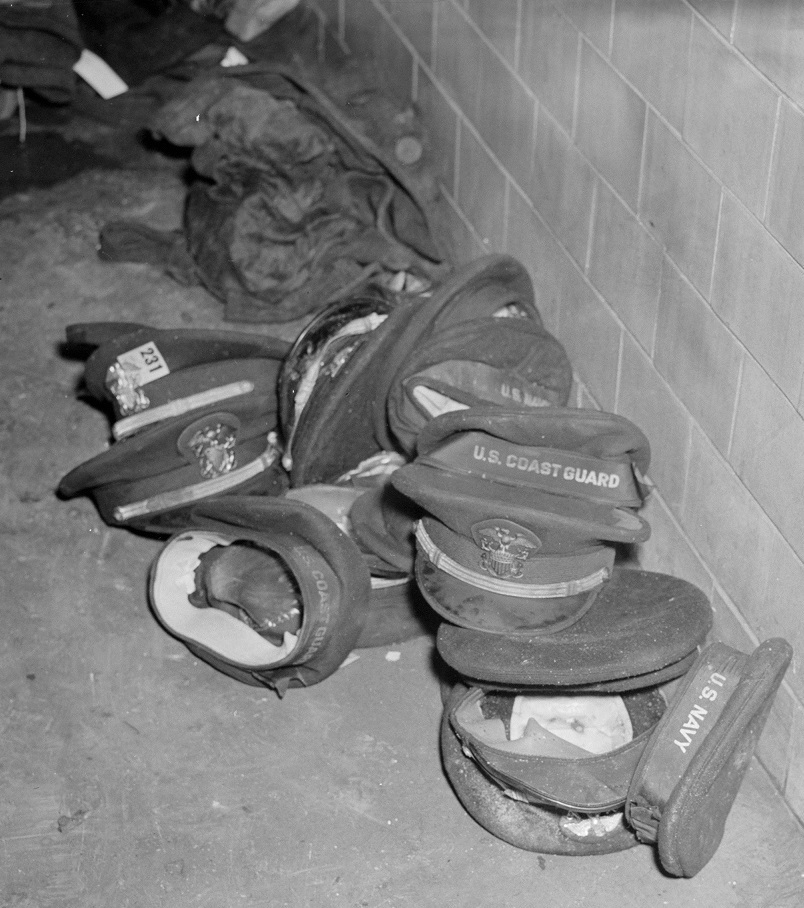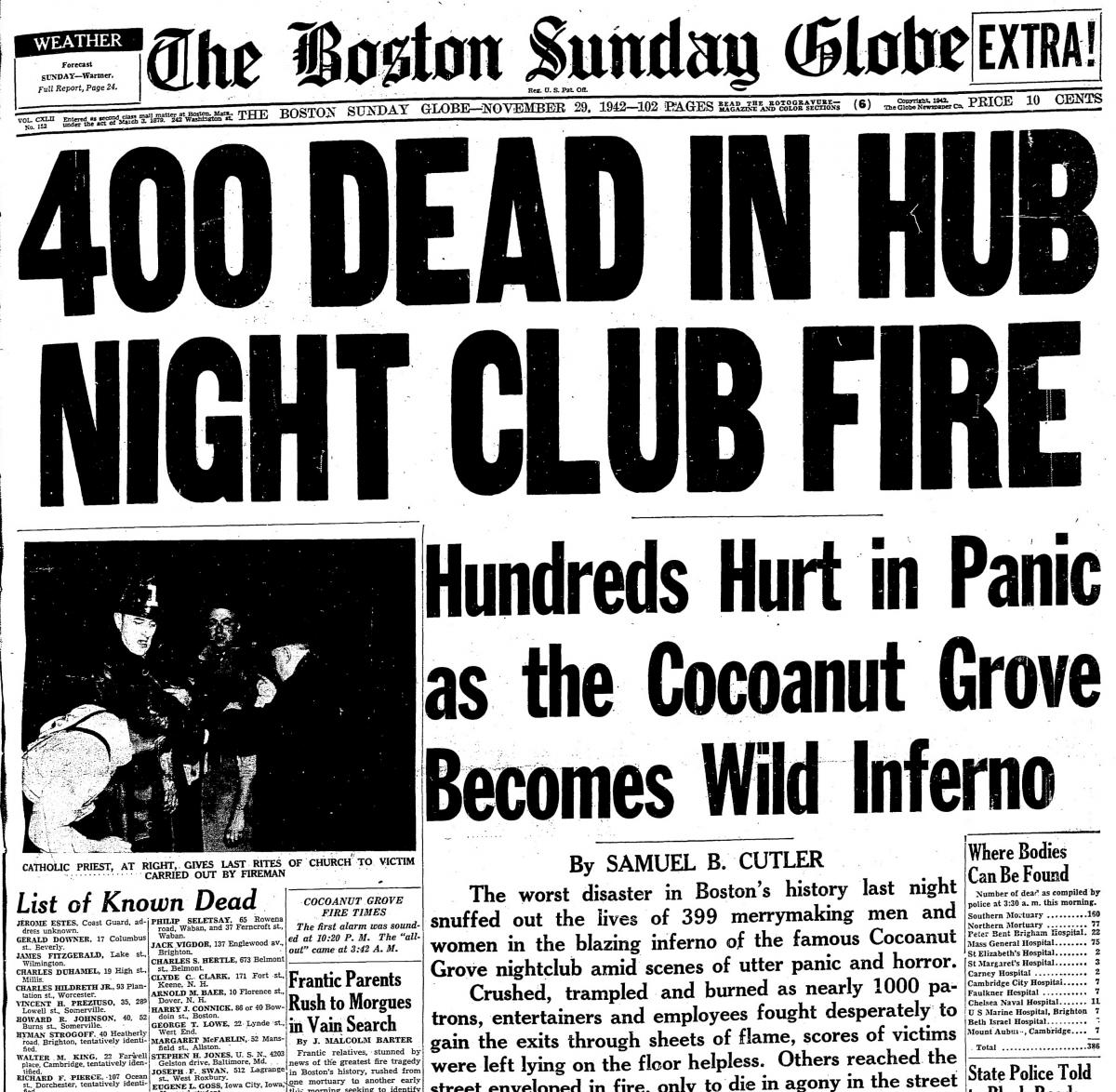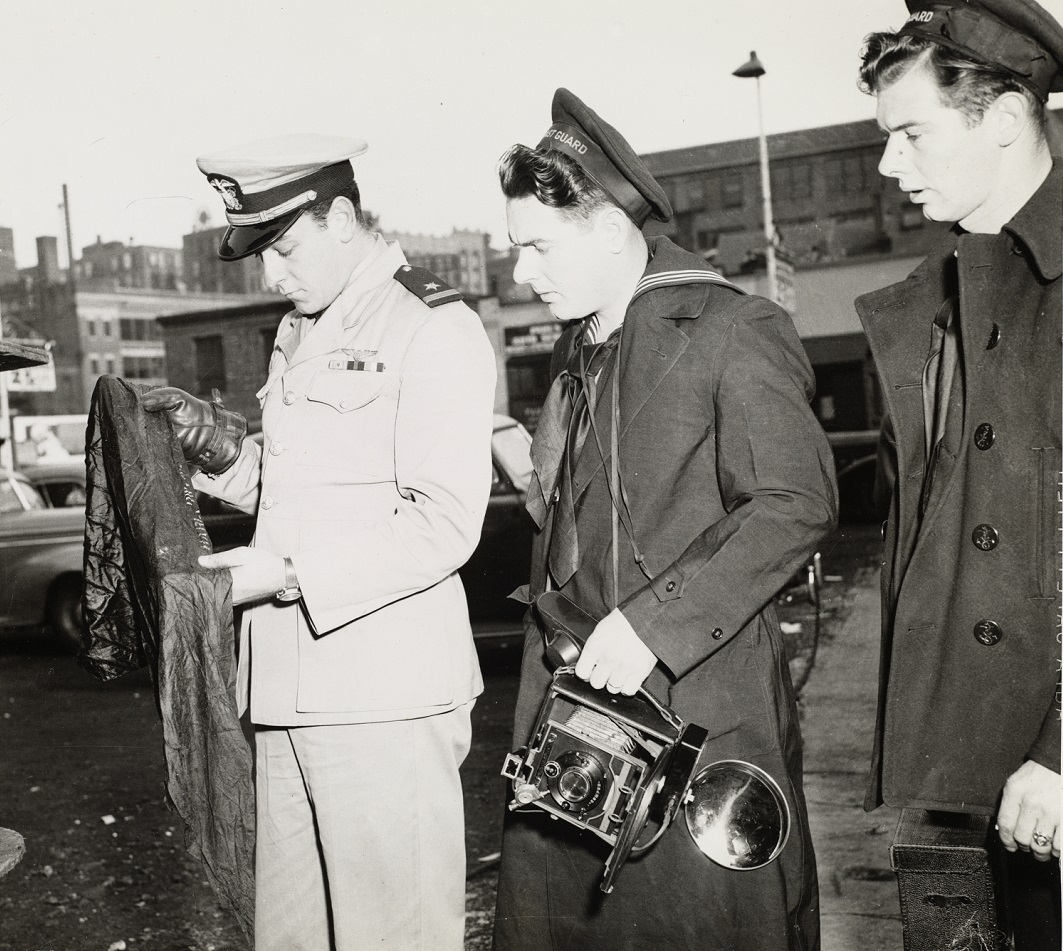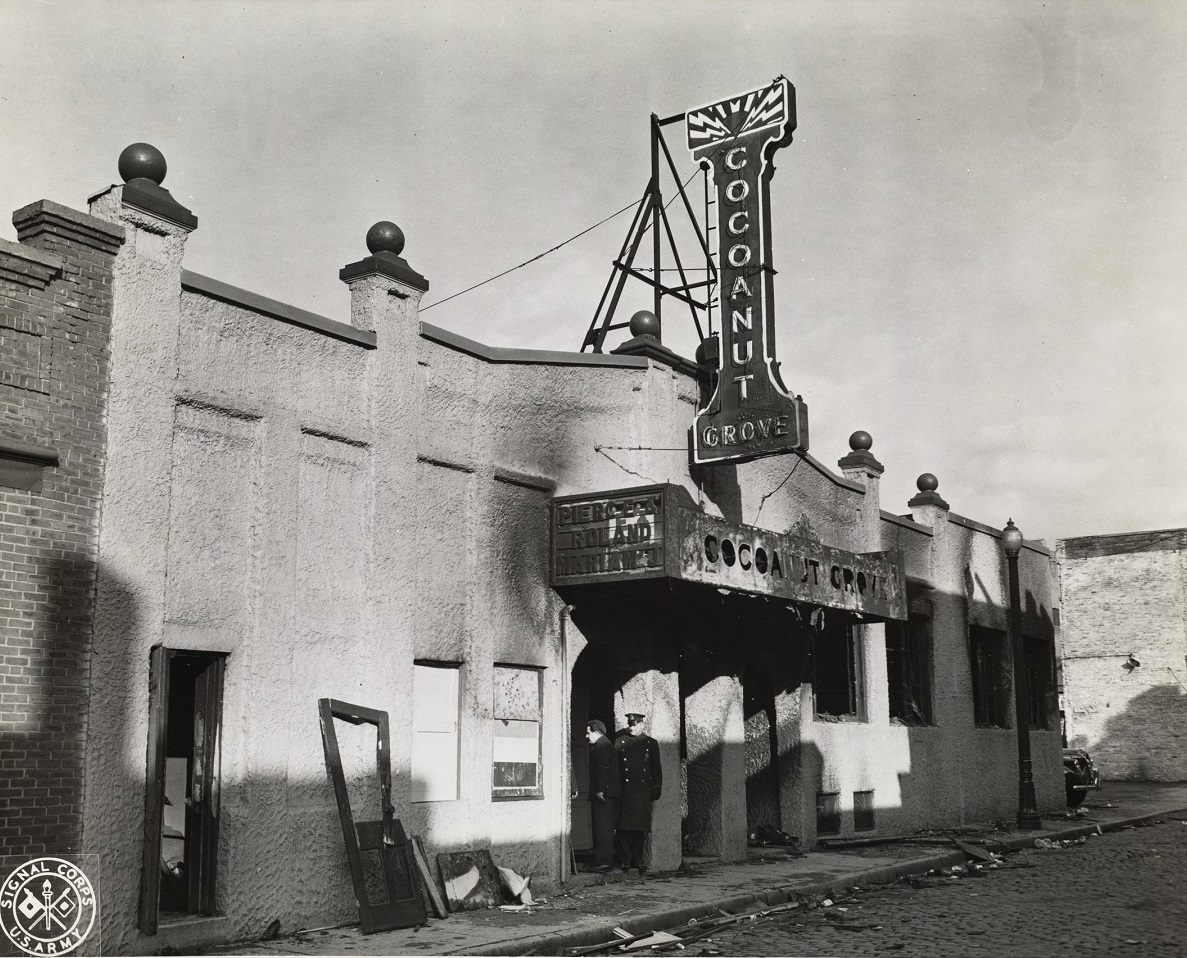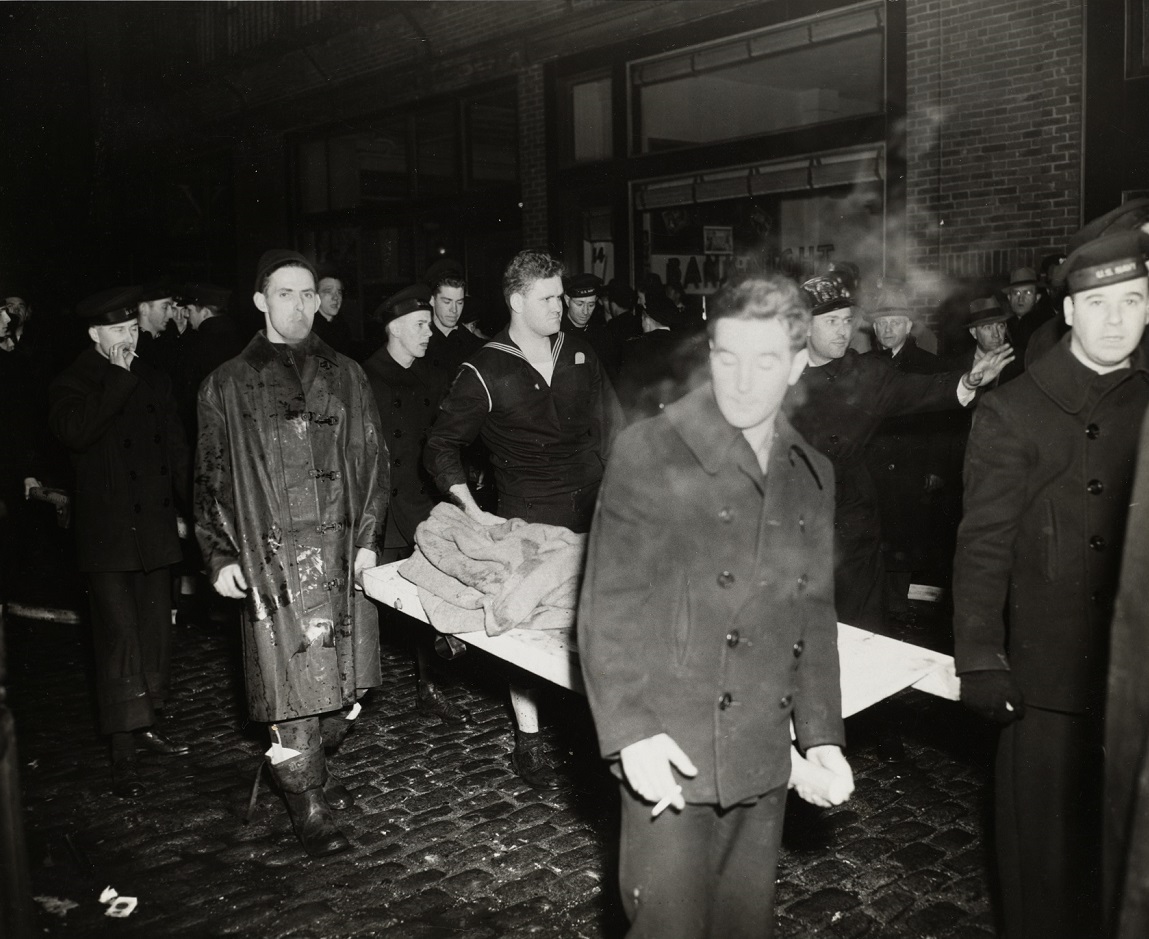
The Cocoanut Grove Revisited
U.S. Navy Records Document How 492 Died in a Deadly Nightclub Fire 75 Years Ago
Fall 2017, Vol. 49, No. 3
By Daniel J. Fleming
Saturday, November 28, 1942, at the U.S. Navy Yard in Boston, Massachusetts, had been, for the most part, a relatively uneventful day.
According to the duty log, 19 ships were berthed at the yard or at nearby auxiliary piers along Boston Harbor. Duty officers performing periodic patrols took note of the vessels that navigated in and out of the yard and the South Boston Naval Annex throughout the calm yet cold, freezing day. Indeed, such activity was common for this strategic shipbuilding facility, which produced and repaired numerous vessels for use during World War II.
However, before Saturday had elapsed, the sailors and Marines of the yard would heed a call for aid that was anything but routine.
Boston newspapers greeted their readers with the day’s updates of the war in Europe and the Pacific, which, nearly a year after the attack on Pearl Harbor, had become and would continue to be regular practice throughout the war. In late 1942, Bostonians were reading of the Allies’ months-long struggle against the Imperial Japanese forces at Guadalcanal and the Soviet Red Army’s counteroffensive against the German Sixth Army at Stalingrad.
Local college football fans diverted their attention to Fenway Park for the annual late-season Jesuit-school rivalry game, in which the Holy Cross Crusaders achieved a stunning 55-12 upset victory, over the top-ranked Boston College Eagles, denying BC an undefeated season and an invitation to the Sugar Bowl.
Despite the outcome of the game, it was Thanksgiving weekend, and many servicemen throughout the First Naval District were looking forward to enjoying leave away from their duties. For many officers and enlisted men with free time, it was an opportunity for an evening of dinner, drinks, and dancing with their dates. And there were few more desirable places to do just that in Boston than at the famous Cocoanut Grove night club.
At 10:15 p.m., a Small Fire Begins to Spread Quickly
For nearly a decade following the end of Prohibition, “The Grove,” located in the Bay Village neighborhood of Boston, was one of the most popular social scenes in the city. Sporting a South Seas–style ambiance, the club treated patrons to food, hospitality, and entertainment, as well as the occasional appearance of music artists or movie stars gracing the dinner-goers with their presence.
On this Saturday night, more than 1,000 patrons packed the main dining room and cocktail lounges at the Cocoanut Grove. Despite the cancellation of a Boston College victory celebration after the football team’s defeat that afternoon, the club had no difficulty in filling the establishment, especially with a floor show about to begin.
Then suddenly, at approximately 10:15 p.m., a small fire broke out in the club’s basement Melody Lounge. Eyewitnesses recounted that they had first spotted the fire in a decorative palm tree in the lounge, working its way up to the ceiling. According to U.S. Naval Reserve Ens. William G. Burns, who had been present in the Melody Lounge around that time, the fire began slowly and appeared to be of such a nature that club employees could extinguish it. Suddenly, to everyone’s alarm, the fire raced across the ceiling, causing the crowd to scatter for safety.
Within eight minutes of the first sight of flames, the fire, fueled by ample wall and ceiling decorations, had engulfed the entire club, spreading upstairs into the street-level foyer and main dining room. As shouts of “Fire!” rang out while heavy smoke and flames emerged from downstairs, the club lights went out and panic ensued. U.S. Naval Reserve Lt. John Kip Edwards, Jr., who had been upstairs in another of the Grove’s lounges and escaped the fire, noted that “it seemed that when the lights went out everybody’s intellect went with them.”
Black Smoke, Darkness, and Jammed Doors
Unable to see and increasingly unable to breathe due to the billowing, black smoke, patrons stumbled over dining room furniture, frantically searching for a way out of the danger. Amidst the chaos and confusion, many were trampled and crushed, especially at the club’s main exit, a revolving door that jammed after being overwhelmed by the rush of patrons seeking to escape.
A second outlet, consisting of an inward-opening door, effectively became a wall as the panicked crowd pushed forth in an attempt to flee to the streets. Additional exits, if they could be located in the dark, were either blocked or obscured, leaving hundreds trapped within the inferno, desperately hoping for outside rescuers to break through the barriers.
Those unable to escape during the fire’s first moments faced little chance of survival, given how rapidly the fire spread and consumed the building. In the end, the conflagration would claim the lives of 492 persons—a count exceeding the building’s approved occupancy level. Causes of death were mainly due to asphyxiation and extreme burns sustained from the fire. To this day, the Cocoanut Grove is remembered as the location of the deadliest nightclub fire and second deadliest single-building fire in American history, only surpassed by a 1903 fire at Chicago’s Iroquois Theatre that took 602 lives.
Boston firefighting units had responded to the Grove just moments after the blaze began, and, almost as quickly, realized the severe, life-threatening nature of the fire and the dire need for additional resources to combat it. Within a 45-minute span, Boston’s Fire Alarm Headquarters received five alarms, and city officials put out a call for all available ambulances to rendezvous at the night club.
At 10:45 p.m., the Boston Navy Yard received that call for aid from the Boston Police Department and immediately mobilized every resource at their disposal. As the duty log notes, the Marine Barracks dispatched three trucks manned with five men each, while the yard’s medical crew produced six station wagons with drivers and hospital corpsmen. They raced the approximate 3.5-mile route from the Navy Yard to the Cocoanut Grove in Bay Village.
Many other military stations within the city and in the surrounding region also responded and rallied personnel to the scene of the fire. Among these were the U.S. Naval Hospital in Chelsea, Massachusetts, which dispatched three ambulances with stretchers, four medical officers, and 12 hospital corpsmen. The U.S. Coast Guard’s Shore Patrol dispatched two companies of men with stretchers and trucks, while the Naval Shore Patrol provided 60 men with stretchers and beach wagons. Individual servicemen, who had been in the neighborhood that evening and observed the situation, responded to provide assistance as well.
Military, Civilian Personnel Work to Rescue Victims
Once on scene, these sailors, Marines, and Coast Guardsmen coordinated with city emergency response personnel to provide crowd control in the immediate vicinity of the nightclub (alongside Army military police units), to break down building exits, to rescue and care for those injured, and to recover the dead. They systematically formed stretcher lines to remove victims from the still burning building and to bring them into waiting ambulances for transport to one of the many hospitals throughout the city, or, in the case of the deceased, to one of the two city mortuaries.
Describing the magnitude of the work being performed by naval personnel, Lt. Comdr. John J. Reilly of the Naval Shore Patrol recounted that Navy units had removed 165 bodies from the building through one exit alone. Boston’s police and fire officials would later compliment the servicemen for their superb work in accomplishing such near-impossible tasks in short order. Reilly recalled Boston Police Capt. James T. Sheehan offering high praise when he stated, “Nothing can take the place of discipline and training. The Navy boys were grand.”
In his official report on the fire, Boston Fire Commissioner William Arthur Reilly took note of the “incalculable value” of assistance rendered at the Cocoanut Grove by so many organizations, including the military and civilian defense units located in the Boston area.
While rescue and recovery efforts were ongoing, the First Naval District sought to account for all of its personnel and to verify the nature of any serviceman’s absenteeism from their duties. According to the Administrative History of the First Naval District in World War II, by early 1943, the district comprised approximately 17,000 enlisted men, 4,000 officers, and tens of thousands of civilian employees stationed at bases and installations throughout its jurisdiction, stretching from Newfoundland to Newport, Rhode Island.
Accounting for this sizable force spread out across a wide geographic region required keen coordination among the district’s many units. Navy medical staff established temporary posts at the city’s civilian hospitals to identify any military personnel whom may have been transported there. Those who could be transferred to Chelsea Naval Hospital were moved accordingly so that they could receive the Navy medical resources intended for them while also alleviating the strain on civilian hospitals.
Similarly, the First District assigned personnel to the city mortuaries in order to identify the bodies of deceased servicemen and to facilitate transfer of their remains to Chelsea Naval Hospital. District intelligence officers also canvassed the hospitals and mortuaries, as well as the scene of the nightclub itself, to ascertain information that might explain how the fire occurred and why so many had perished.
Searches Are Launched to Identify Dead, Injured
Numerous dispatches were sent and received between the commandant’s office at the Boston Navy Yard and posts throughout New England, seeking to share and obtain information as to the whereabouts and status of absent officers and enlisted men, and whether they might have attended the Cocoanut Grove that evening.
At the U.S. Naval Training School located at Harvard College, officers established a call center to facilitate such communication in order to determine the status of unaccounted for trainees and personnel.
One missing officer, Ens. John Bauer, stationed at the Navy’s communication school at Harvard, had not reported for duty during the first three days following the fire. Students at the school informed officers that Bauer had gone to the Cocoanut Grove on Saturday night and feared the worst for him. While his wallet and uniform cap had been recovered from the nightclub following the fire, his body had not been identified, and companions who might have been able to corroborate Bauer’s whereabouts had either died at the Grove that night or were in life-threatening condition in hospitals. Then on December 7, eight days following the disaster, the district’s medical corps confirmed that they had identified Bauer’s body through dental records and other personal markings on clothing, verifying that his death was a direct result of injuries sustained during the nightclub fire.
Bauer’s fate was one of hundreds that would be reported by Boston newspapers as information was learned and disseminated in the days and weeks following the tragedy. On Sunday morning, November 29, the Cocoanut Grove fire dominated the headlines in Boston, and would do so for several days, displacing war updates that normally would have been front page news. Even other big city dailies, such as the New York Times and the Washington Post, made room on their front pages to report on the events in Boston.
The media printed firsthand accounts of the fire from survivors, eyewitnesses, and emergency responders while publishing lists of the victims, as well as those injured and hospitalized, as such information could be verified. The death of Buck Jones, a popular movie star of the era and attendee at the nightclub, also made national news.
Busboy Is Cleared of Any Wrongdoing
Newspapers also printed stories speculating upon the causes of the tragedy and who might be to blame. One explanation for the fire’s origin that quickly gained traction in the papers was the role played by Cocoanut Grove busboy Stanley Tomasewski.
In an interview with Boston fire investigators, the young employee described how he had replaced an extinguished light bulb in a corner of the dimly lit basement Melody Lounge. Presumably, a couple seeking privacy had removed the light bulb from its fixture. Tomasewski, acting on a club manager’s directions to replace the light bulb at once, lit a match in order to see his surroundings, replaced the bulb, and extinguished the match.
Media reports immediately speculated on the busboy’s culpability, for eyewitnesses had first observed the fire close to where Tomasewski had been working. In his official report, however, Fire Commissioner Reilly stated that, after reviewing the evidence, as well as Tomasewski’s testimony, he was unable to conclude that the busboy’s conduct had caused the fire. In fact, Reilly’s report would officially determine that the cause of the fire was of an unknown origin.
Further public and media scrutiny focused on city officials who were responsible for enforcing safety and building codes for businesses such as the Cocoanut Grove. While Boston’s mayor, Maurice J. Tobin, promised an immediate inquiry into the fire, many doubted that city investigations would yield the accountability needed and desired by the public.
Suspicions concerning Cocoanut Grove owner Barnett Welansky’s associations with Tobin and other local officials prompted questions about whether those relationships had compromised the city’s ability to enforce building compliance and to perform objective investigations in the aftermath of the fire. Welansky, a lawyer who had represented Boston mob boss Charles Solomon, had taken ownership of the Cocoanut Grove after Solomon died in 1933.
In the years following the repeal of Prohibition, Welansky sought to build the club into the premier nightlife spot in the city. But in his zeal to achieve success and profit, Welansky disregarded city building standards and permitting processes as he renovated and expanded the club. As the public became further aware of Welansky’s noncompliance and the absence of sanctions imposed against the club for building violations, many wondered whether city officials had condoned Welansky’s behavior and for what purposes.
Appeals for Aid, Reform Made to U.S. Navy Officials
Given this political climate in Boston, those interested in seeking accountability and public building safety reforms petitioned for assistance from more reputable authorities, such as the U.S. Navy.
In a December 21, 1942, letter to Secretary of the Navy Frank Knox, Alfred Bauer, now a gold star father of the late Ensign Bauer, offered a measured plea that the Navy investigate and intervene with local authorities in order “to protect other Navy boys and service men against such a debacle and ignominious end to their lives and service careers.”
On January 5, 1943, Alfred Bauer’s letter reached the First Naval District commandant, Rear Adm. Wilson Brown. By that time, the admiral was aware of the recommendations for remedial legislation offered by Massachusetts Governor Leverett Saltonstall in his recent inaugural address and deemed that the Navy need take no further action regarding the matter.
Alfred Bauer may have been unaware that the First Naval District had made no delay in pursuing its own investigation to determine why so many armed services personnel had perished at the Cocoanut Grove. Less than 24 hours after the fire, Brown had convened a board “for the purpose of investigating and reporting upon the circumstances attending the deaths and injuries to officers and enlisted men of the U.S. Navy, U.S. Marine Corps, and U.S. Coast Guard.”
This board of investigation gathered evidence and held seven days of hearings to acquire witness testimony from the district’s medical and intelligence units regarding the identification of deceased servicemen and the logistical operation of Navy resources: from officers who participated in the mobilization of support to the scene of the fire, including Lt. Comdr. Reilly, as well as from sailors present at the nightclub, such as Ensign Burns and Lieutenant Edwards, who could provide firsthand accounts.
On December 10, the board concluded its investigation and issued its findings of facts and opinion. The board identified that, as of the date of their findings, 39 servicemen (31 Navy, 5 Coast Guard, 3 Marine Corps) had died as a result of the Cocoanut Grove nightclub fire, while 27 (19 Navy, 8 Coast Guard) had sustained injuries. The casualties at the club had resulted mostly from either asphyxiation due to the heavy toxic smoke filling the building or burns sustained from the fire itself. All of these servicemen had been on authorized leave from their duties.
Probe Found Exits Blocked or Sealed
The board also determined that the significant loss of life was exacerbated by the building’s lack of effective exits. None of the club’s exits were marked, and those exits that were known to the public, such as the main revolving door, became blocked in the mad rush to evacuate. While service doors allowed many employees and a small number of patrons to escape, most customers had no knowledge of these passageways and would not have known to use them. One exit was equipped with a “panic” lock, designed to release its door open in the event of an emergency. However, the lock had been overridden by a bolt securing the door shut, rendering the exit useless. During the post-fire inspection of the club, another exit was discovered to have been removed and replaced by brick wall. The public and the media suspected that Welansky had locked or blocked a number of the club’s exits in order to deter deadbeat patrons from attempting to evade paying their tabs.
Criminal investigations would result in a grand jury’s indictment of Welansky on charges that he had contributed to the deaths of hundreds at the Cocoanut Grove by failing to abide by building standards and allowing overcrowding. For the state court trial jury, it was immaterial whether he was aware of the life-threatening risks of disabling exits. On April 10, 1943, the jury convicted Welansky on 19 counts of manslaughter. Welansky was sentenced to a prison term of 12 to 15 years, but was released in 1946, and died shortly thereafter, due to failing health. Nine others, including a Boston fire lieutenant, police captain and building inspector, as well as employees and contractors of the club, faced charges related to building code violations and lax enforcement, but almost all were acquitted.
The Cocoanut Grove fire shocked and saddened the nation, but this tragedy inspired a resolve to improve the safety and security of the American public both during the war and in following years. The fire became an impetus for enacting safety reforms and code enforcement.
The fire commissioner’s report made a number of recommendations to improve the safety of public buildings and to increase the chances of escape and survival in the event of an emergency. Among these measures, the report called for the installation and use of automatic sprinklers; the equipping of exit doors with panic locks and the use of powered, illuminated “EXIT” signs; improving and increasing egress in public assembly spaces; as well as the prohibition of flammable fabrics or materials in such spaces.
Since this tragedy, many states, as well as the U.S. government, have passed measures intended to improve fire safety standards, while fire prevention organizations continue to advance the study of fire safety and advocate for implementation.
In the decades following the fire and the conclusion of World War II, with the needs of the Navy changing in the face of new global conflicts, the Boston Navy Yard gradually reduced its production of new vessels and officially closed as an active installation in 1974. Today only a portion of the yard remains open in order to support the maintenance and operation of America’s oldest commissioned warship, USS Constitution.
Despite these changes over time, the character of those who answered the call for aid on November 28, 1942, is remembered and continues to inspire today. In a letter thanking Mayor Tobin for his appreciation of the Navy’s assistance at the Cocoanut Grove, Rear Admiral Brown took solace in the performance of all those who provided assistance, stating:
I think that perhaps we are justified in deriving some mild consolation for the tragedy in the behavior of all of our people—Service and civilian—as it provides some measure of their behavior if our cities should ever be subjected to enemy air attack. To me it is comforting to know that we can always rely on courage, presence of mind, and united action.
Daniel J. Fleming is an archives technician at the National Archives at Boston and a Certified Archivist. He earned his bachelor’s degree in history from Boston College and his master’s degree in history/archives from the University of Massachusetts-Boston.
Note on Sources
A researcher visiting the National Archives at Boston to access correspondence files of the First Naval District Commandant’s Office keenly observed that a file marked with the U.S. Navy Filing Manual subject term “L-11-Salvages” included a substantial amount of material pertaining to the Cocoanut Grove disaster and brought it to the attention of Archives staff.
In recognition of this year’s 75th anniversary of this significant event in Boston’s history, the National Archives at Boston has digitized this file unit and made it available on the National Archives Catalog. It is hoped that these records will enhance and support existing research on the tragedy while further fostering the public’s knowledge and understanding of this subject.
The author consulted the following materials of Record Group 181, Records of Naval Districts and Shore Establishments, held by the National Archives at Boston:
Administrative History of the First Naval District in World War II (series) [National Archives Identifier 1138081].
Boston Navy Yard Log Entry, November 28, 1942 (item) [National Archives Identifier 6924864] contained by Shipyard Logs (series) [National Archives Identifier 1175011]. This item is available for viewing on the National Archives Catalog.
L-11-1—Salvages—Casualties: Cocoanut Grove Disaster (file unit) [National Archives Identifier 30623174], contained by General Correspondence s) [National Archives Identifier 1137274]. This file unit is available for viewing on the National Archives Catalog.
To supplement the historical content of this article, the author consulted the following sources outside the National Archives that support the research of this subject:
John C. Esposito, Fire in the Grove: The Cocoanut Grove Tragedy and its Aftermath. Cambridge: Da Capo Press (2005).
Historical newspaper editions of the Boston Globe, New York Times, and Washington Post, accessed via ProQuest Direct. Full text of New York Times and Washington Post newspapers are accessible on ProQuest Direct at National Archives research locations nationwide.
William Arthur Reilly, Report Concerning the Cocoanut Grove Fire, November 28, 1942. Accessed online at Internet Archive.
The Cocoanut Grove Fire (www.cocoanutgrovefire.org), a website of the Cocoanut Grove Coalition.
